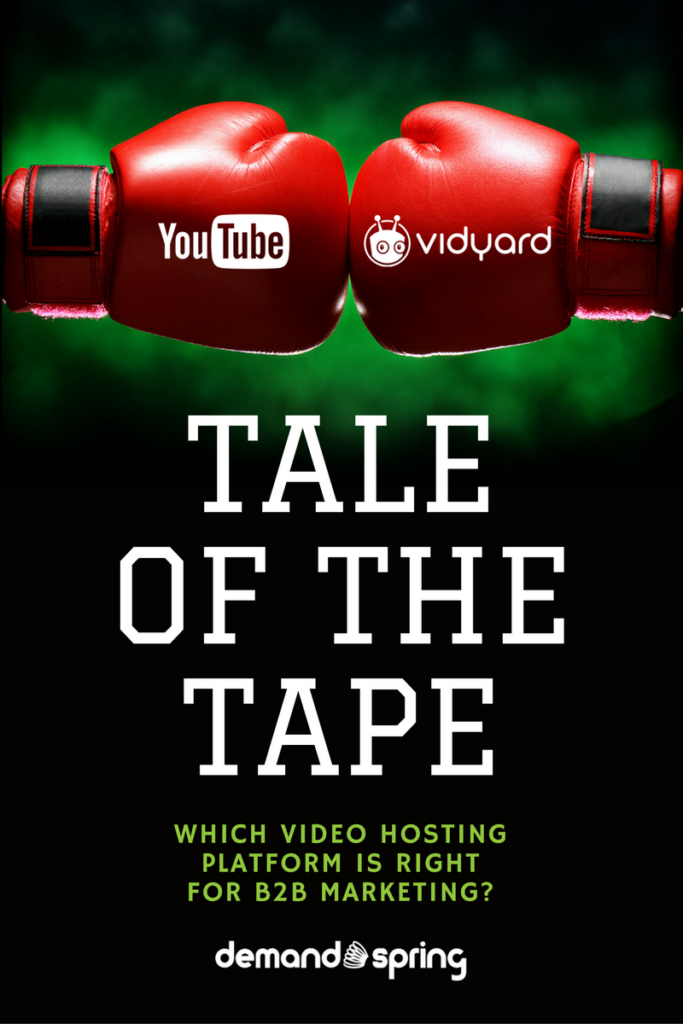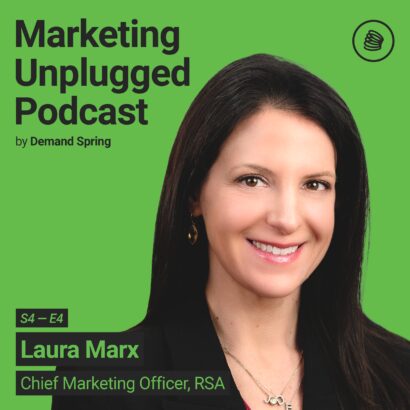“Which B2B video marketing platform is better? YouTube or Vidyard?”.
We hear this question a lot, and there’s a good reason for it.

Another common question we hear is, “Why would I pay for a video marketing platform if YouTube is free?”.
Well, let me first say that nothing in the marketing world is actually “free”. Sure, it’s free to post videos to YouTube, but it doesn’t help you drive new business through the enriched features a top video marketing platform would.
As with social media, different video marketing platforms require different strategies.
Now for the main event, the tale of the tape as it were.
It’s YouTube versus our video marketing platform of choice — Vidyard — and how each are effective B2B video marketing platforms.
Video player features
On the surface, these video players appear to do very similar things. But when you take a look under the hood, you’ll notice a tremendous amount of difference, each of which impacts your video marketing efforts.
For now, let’s take a look at the visible features…
YouTube
- Sharing buttons: Share videos on social media directly from YouTube, which will link back to the YouTube player, not the web page, whether it’s embedded or not.
- Info cards: These allow you to generate traffic to other YouTube videos on your channel or other landing pages after you connect your website to your YouTube account.
- Annotations/calls-to-action: Make your videos semi-interactive and link your videos to other YouTube videos or a company website page using a clickable box overlay.
- Pre-roll advertisements: Not only is your viewer interrupted before watching your video, a random business or even competitor can advertise their offering before you even have the chance… despite clicking on your video first.
- Post-roll recommendations: Once the video finishes, YouTube’s algorithm recommends any video they want to your viewer based on their search history. Anything from cats to laughing babies, or worse yet, your competitor’s explainer video.
Vidyard
- Customizable video players: For branding enthusiasts, Vidyard provides branded video players that allow you to match your colors, lock embed sizes, and choose between inline or lightbox embed options.
- Sharing buttons: Like YouTube, you can share videos directly from a Vidyard player. Unlike YouTube, the share will link to the page you shared it from, not to the player.
- Built in calls-to-action: Similar to YouTube, you can build clickable buttons that direct to new content. Vidyard provides popouts and interrupted or uninterrupted lead gates, allowing you to generate leads within your video.
- No advertisements: When your prospect clicks your video link, they aren’t interrupted by a random advertisement. They remain focused on what’s important! Your business!
- Post-roll recommendations: After your video is viewed, you have complete control of the content that comes next. You can recommend any video, blog, whitepaper, or even case study directly from a Vidyard player. No more cat videos, though I have nothing against cats.
Lead Gen + Integrations
Lead gating, as mentioned, is a huge differentiator between YouTube and your top performing video marketing platform (ahem, Vidyard).
Vidyard allows viewers to submit their information directly into the video player rather than being directed to a landing page with a lead form. This reduces the number of steps a prospect must take to engage, helping you generate leads more efficiently.
When people think “lead gen” they often associate the term with a marketing automation platform (MAP), a tool that automates marketing actions.
These actions could include everything from emails, social media, website actions, and so on.
Marketing automation platforms such as Marketo work well with enterprises that have massive lead lists, with little time to communicate.
The beauty of Vidyard is that it not only stores these new leads in Marketo, but it also tracks all of the other videos the prospect has watched before and after submitting their contact info!
Analytics
YouTube and Vidyard both provide insightful analytics. However, the modern marketer craves the best possible data to learn more about prospect habits.
Both provide average view time, views by time, device breakdowns, and geographic location. However, there are differences:
YouTube
- Traffic sources: YouTube viewership information tells you how your viewer found your video. For example, it knows if the view came from a social media share, a YouTube recommendation, or a YouTube advertisement, among others.
- Average view duration: The average viewership rank of a particular video. Note that it doesn’t show the name of the viewer or how many times they watched your video.
Vidyard
- Click through rates: The number of times a video is viewed divided by the number of times it has been presented to a visitor. Your clickthrough rate is similar to an email open rate (how many emails were opened divided by how many people you sent it to). A video click through rate is a good indicator of how relevant your video is on specific web pages.
- Engagement data: Helps you understand what parts of your videos are most, and least watched. This helps you plan for future content and helps you put your video’s performance in context by telling you which people are dropping, or re-watching videos.
- Visitor information: After completing a lead form within a Vidyard player, the system tracks individual viewership and engagement data.
YouTube measures views and how they found your video. Vidyard measures specific viewer behavior, helping you develop a long-lasting video marketing strategy.
YouTube is about views, and Vidyard is about leads.
Which one should I use?
Back to the main question: which is the better B2B video marketing platform?
Well, it depends on the business you’re in, and what your goals are.
If you represent a big brand looking to generate exposure, YouTube is amazing. And yes, YouTube videos typically can score better than videos hosted on your website because YouTube is owned by Google.
However, this doesn’t necessarily mean you should throw all your videos on YouTube (significantly reducing the likelihood of generating new leads as you do).
If you’re focused on demand generation, you know that driving traffic to other resources is a key part of the modern sales cycle.
Here’s a handy guide that will help you decide where to post your videos.
- For views, awareness, and subscribers: YouTube.
- To generate new leads, create ROI, keep people on your site, and recommend content: Vidyard.
Use them together!
Here’s the reality. It’s not a question of one or the other. Both YouTube and Vidyard have different purposes, and both should be part of your marketing mix.
Here are three ways to use them together:
- Don’t post the same video on YouTube and Vidyard. The last thing you want is to have the same video on two platforms fighting for clicks.
- Use both platforms for light video content. It’s ok to post your lighter videos, those that are higher in the sales funnel (your “get to know us” videos) on both YouTube and Vidyard. On YouTube, this helps increase your social media presence, and can be a good first step in turning a viewer into a customer.
- Post “teaser videos” to YouTube, and link to the longer version on Vidyard. YouTube videos are typically preferred with search engines. Hosting teaser videos on YouTube and linking calls-to-action to the full video hosted on your website in a Vidyard player is an effective way to funnel viewer interest as you take them on a content journey. The same goes for other social media platforms such as Facebook, Twitter, and LinkedIn! By using YouTube players for teaser content, your videos now compliment each other rather than compete for clicks. This allows you to hone in on the prospects that matter and provide content to those who want it. From there you’ll have more precise analytics and prospect viewership data.
Final round
Ding! Ding! Ding!
The judges have made their decision. The scorecard reveals an edge in B2B scoring in favor of Vidyard, though YouTube remains a strong contender not to be ignored for top of funnel video offerings.






